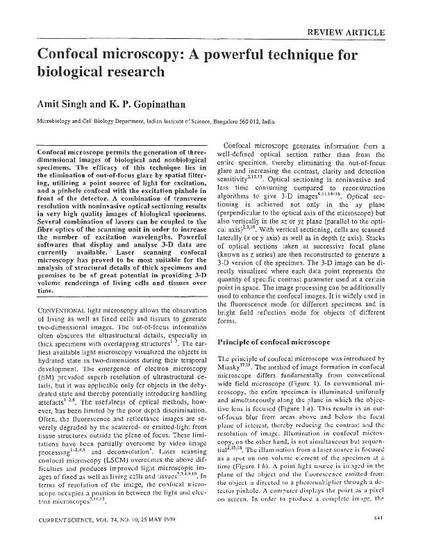
Conventional light microscopy allows the observation of living as well as fixed cells and tissues to generate two-dimensional images. The out-of-focus information often obscures the ultrastructural details, especially in thick specimens with overlapping structures. The earliest available light microscopy visualized the objects in hydrated state in two-dimensions during their temporal development. The emergence of electron microscopy (EM) provided superb resolution of ultrastructural details, but it was applicable only for objects in the dehydrated state and thereby potentially introducing handling artifacts. The usefulness of optical methods, however, has been limited by the poor depth discrimination. Often, the fluorescence and reflectance images are severely degraded by the scattered- or emitted-light from tissue structures outside the plane of focus. These limitations have been partially overcome by video image processing and deconvolution. Laser scanning confocal microscopy (LSCM) overcomes the above difficulties and produces improved light microscopic images of fixed as well as living cells and tissues. In terms of resolution of the image, the confocal microscope occupies a position in between the light and electron microscopes.
Confocal microscope generates information from a well-defined optical section rather than from the entire specimen, thereby eliminating the out-of-focus glare and increasing the contrast, clarity and detection sensitivity. Optical sectioning is noninvasive and less time consuming compared to reconstruction algorithms to give 3-D images. Optical sectioning is achieved not only in the xy plane (perpendicular to the optical axis of the microscope) but also vertically in the xz or yz plane (parallel to the optical axis). With vertical sectioning, cells are scanned laterally (x or y axis) as well as in depth (z axis). Stacks of optical sections taken at successive focal plane (known as z series) are then reconstructed to generate a 3-D version of the specimen. The 3-D image can be directly visualized where each data point represents the quantity of specific contrast parameter used at a certain point in space. The image processing can be additionally used to enhance the confocal images. It is widely used in the fluorescence mode for different specimens and in bright field reflection mode for objects of different forms.
Available at: http://works.bepress.com/amit_singh/10/

Document is made available for download consistent with the current policies of the publisher at the time of posting. Permission documentation is on file.